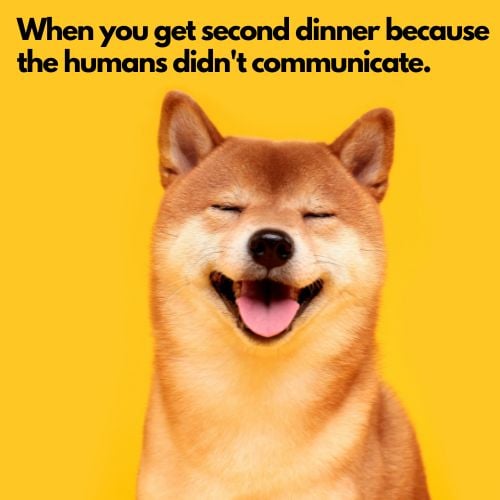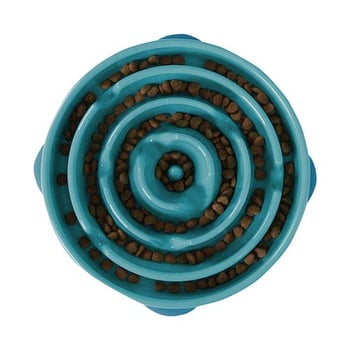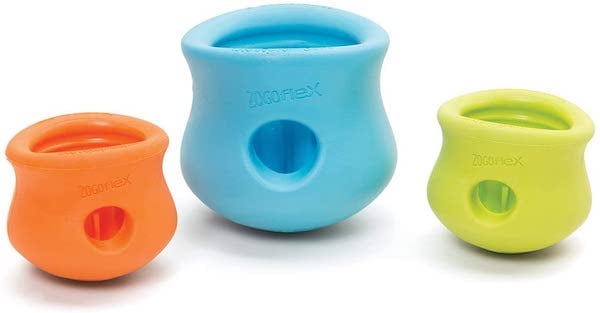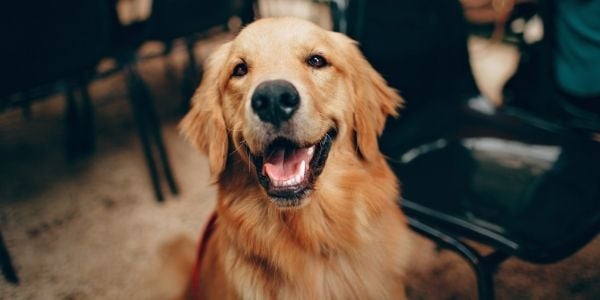
Mealtime for my sweet Tessa was like a magic show. Before you could say “abracadabra,” her food was gone. Then poof, all the food reappeared!
Following the magic show was a wrestling match. The thought of her eating her vomit made me want to vomit. So, I would desperately try to clean it up with a paper towel as she tried to clean it up with her tongue.
Unfortunately, all this was before there were slow-feeder bowls and other options on the market. The good news is that I still found a remedy that worked for us both!
If you are reading this, you likely are having the same issues I did. The good news is that there are many more options to manage fast eaters now than there were. Hopefully, we can find you and your dog a solution, too!
Understanding the cause of your dog's speedy eating habit can help you find the right solution.
Skip to section:
Why Do Dogs Eat Too Quickly?
There are different reasons a dog might eat too quickly, and understanding the cause, in some cases, can help you create the solution.
Medical Conditions
There are underlying medical conditions that may cause your dog to speed eat. Hormonal issues, such as with Cushing’s disease or thyroid conditions, can dramatically increase your dog’s appetite. These conditions can be diagnosed by your veterinarian with specialized blood tests.
Parasites
Intestinal parasite infestations can make a dog intensely hungry since the parasites can interfere with the absorption of nutrients. Monitor your dog’s poop daily. Bringing a sample to your veterinarian is important to help rule this in or out as a cause.
Nutritional Deficiencies
Dog food that isn’t well-balanced and nutritionally complete results in your dog having nutritional deficiencies that cause them to be hungry and require more food to meet their basic needs. Your veterinarian can help you determine if your dog is getting the nutrients they need, and if not, they can recommend a high-quality, well-balanced food.
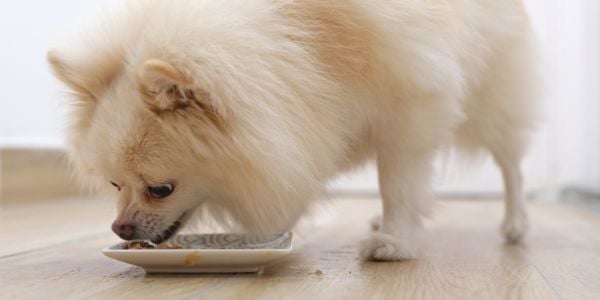
Medications
Medications like steroids (e.g., Prednisone) used to treat infections or diseases can significantly increase your dog’s appetite.
Dog Behavior
Competition over food with other pets in the home can drive dogs to eat quickly. Your dog may just want to guarantee they get their fair share of the goods before another dog (or cat) comes to get it.
Dogs that are adopted either from a rescue or shelter may not know proper feeding etiquette, are unaccustomed to a feeding schedule, or had to find food in the wild. All these factors can cause them to eat quickly. Your dog may learn to eat slower after time, love (lots of it!), care, a few adjustments, and possibly working with a certified dog trainer or veterinary behaviorist.
Behavioral issues, such as anxiety or resource guarding, can cause a dog to eat too quickly. Treating these issues is crucial in slowing down your dog’s eating.
Some theorize that dogs eat so quickly because they don’t need to savor the food since they only have about 2,000 taste buds, compared to people with over 9,000.
Another theory is that eating fast comes down to your dog’s ancestry. When dogs had to scavenge for their food, eating quickly decreased the likelihood of not eating at all. For some dogs, this instinct has stayed through the generations.
Having medical issues or behavioral issues properly diagnosed, treated, and managed is a critical part of slowing down your dog’s eating.
Tips for Slowing Down Your Dog's Eating
Dining for One, Please!
If part of the reason your dog eats so fast is that they feel they need to compete against other pets in your household, feed your pets in different rooms or in crates where they feel secure.
Safety and Security
Just like you want to have a calm and quiet environment to eat in, so does your dog. They need to feel safe enough to slow down and savor their meal.
To help them feel safe while eating, avoid feeding in:
- High traffic areas
- Loud or noisy locations
- Under bright lights
Reliable Schedule
Life is crazy and unpredictable, so this option may not be a good solution for most. But it is worth a mention!
For some dogs, being fed at the same time EVERY day may give them the needed security and consistency they need to eat normally because they know it isn’t their last meal.
Water it Down
Slow-feeder bowls weren’t invented when I had my dog Tessa, so to slow her down and improve her hydration, I would add water to her food. Enough to just make it float. She would lap some water, get a little food, chew, and repeat. It was a quick, easy, and cheap solution.
This worked for some of my patients as well, but others needed a little more to slow them down.
This method is best used in bowls that your dog can’t tip or spill. A feeding stand is appropriate for this.
Spreader Method
Though the term ’spreader method’ isn’t an official term, you get the point! This is a quick, easy, and cheap option that works well for some dogs. It is what I found works great for my little dog.
You can take your dog’s kibble and spread it out over a yoga mat or snuffle mat. Then they slowly graze along, eating. You can spread wet food over a cookie sheet or in a slow-feeder wobble bowl.
Muffin Tin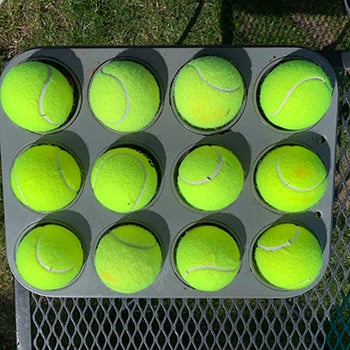
If you are a DIY’er or have multiple dogs who eat fast, try using a muffin pan as their feeding dish. Put some food in each cup, and as they switch from cup to cup, they are forced to eat slower.
To slow them down a little more, you can even add some water or put a tennis ball over the food in each indent.
Blocker Option
You can place a larger tennis ball or chew toy in their food bowl with the food. This makes them eat around the object, which forces them to slow down. Adding a spiral insert can do the trick as well.
Note: The object MUST be large enough that they cannot swallow or choke on it. DO NOT use rocks or sticks as blockers. Not only are they a potential choke hazard, but they can result in serious intestinal issues, such as an intestinal blockage or perforation, that could result in death.
Mini Meals
Depending on your dog and your lifestyle, feeding your dog mini meals can be the key to slowing them down.
You can try this by hand and have your dog perform obedience or trick skills. Feeding this way helps slow them down, provides enrichment, and helps reinforce certain training. Additionally, it helps your bond with your dog.
You can use an automatic feeder that you can program to dispense small amounts of food throughout the day. The Cat Mate feeder is great for smaller dogs, and the DoHonest feeder with a built-in video monitoring system is more appropriate for larger dogs and larger kibble sizes. Remember, the idea is multiple mini meals over the course of the day, so your dog feels satiated throughout the day.
Note: Be sure that the total for the day is divided up based on your dog's total daily caloric requirement. These are mini meals that add up to one full meal.
Mealtime Using Interactive Puzzle Feeders
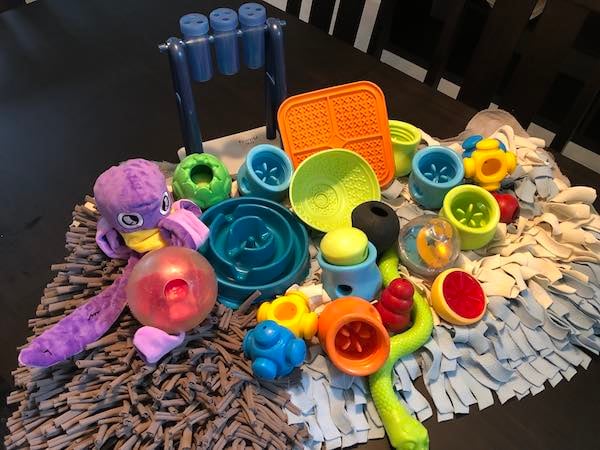
Feeding your dog from an interactive feeder or toy, rather than a standard bowl, may be perfect for them.
For deep-chested dogs that are predisposed to “bloat” (otherwise known as gastric dilatation and volvulus, or GDV), eating more slowly is really important, as it may help to prevent GDV, a condition that can be rapidly fatal.
For high-energy dogs, interactive toys and puzzle feeders can also help to increase their mental stimulation and decrease their boredom, leading to a happier and more exhausted dog. This can be particularly great for dogs prone to separation anxiety and other situations predisposing them to destructive behaviors.
There are lots of great options for interactive toys and puzzle feeders on the market. As you can see from the photo, our dog trainer keeps many on hand and switches them up for her dogs' mealtime. Here are a few of our favorites slow feeders and food puzzles:
If you’ve ever played with Weebles, you can picture the Kong Wobbler. As your dog nuzzles it around, it drops pieces of kibble and then pops back up. Easy to use, sturdy, and dishwasher safe for keeping clean. I love the Wobbler! It comes in small and large; the small may be best for small dogs and puppies. (Note: only for use with dry food or treats, not effective with wet food.) Some people complain about the sound it makes on flooring, as the Wobbler is made of hard plastic. It's quieter on carpeting.
A quieter version of the Wobbler is Orbee's Mazee Ball. You can see Sookie quietly and slowly enjoying her meal while rolling it around.
The Green Feeder is a great way to slow down a dog’s rate of eating (for one of our team members, it slowed down their dog from about 10 seconds to about 3–4 minutes to eat). The Green Feeder is sturdy and dishwasher-safe. It can be used both for kibble and for wet food. It also comes in a mini size for smaller pups.
- Check out Loki enjoying his meal using an interactive feeder.
This “maze bowl” by Outward Hound can go a long way to slowing down a dog’s rate of eating, too. And it’s fun to watch your dog’s brain be engaged as they try to figure out how to get their food out.
The Toppl system by West Paw is the hands-down favorite of Preventive Vet's dog trainer, Cathy Madson. Not only is it made with their proprietary Zogoflex rubber (so it’s durable, dishwasher-safe, and latex-free), but it’s also designed to allow you to combine two Toppls to increase the difficulty for your dog as they get smarter. It's great for kibble and wet food.
See Cathy's dog (as a puppy) using it in the video below.
For more of our favorite interactive feeders, check out this list of different types of puzzle feeders and when to use them.
Supervision
Many dog owners don’t supervise their dog enough when they are eating, especially after they implement some changes to slow their feeding down. It is important to monitor your dog continually. It allows you to assess if the changes are working or not.
Just because they have a slow-feeder bowl doesn’t mean they still aren’t finishing their food too quickly.
If the changes aren’t working, monitoring your dog while they eat will give clues as to what may work better.
You can also determine if they seem calm, overwhelmed, or anxious. This observation can be helpful if you determine you need to seek advice from a certified canine trainer or veterinary behaviorist.
Over or under-filling the bowl
Slow-feeder bowls need to be filled just right – not too much or too little. Typically, filling them 1/3 to ½ full should work. But this depends on the bowl and how much your dog is fed per feeding (another reason bowl selection is important).
Overfilling a slow feeder bowl can, in part, defeat its purpose since the food can easily be eaten quickly, since so much sits above the ridges or comes out too quickly. It can also overwhelm or frustrate your dog, causing anxiety and digestive issues.
Overfilling a bowl can cause weight gain, which can lead to other health issues.
Not filling the bowl enough may allow your dog to still eat too quickly and be left feeling hungry.
Bowl Type
Just like the wrong plate or cup can be problematic for a toddler, choosing the wrong bowl for your dog can lead to problems.
The bowl must suit your dog’s uniqueness. If the ridges or bumps are too high for smaller dogs or the gaps are too narrow for squishy-faced dogs, you may overwhelm them and increase their anxiety. Some bowls are difficult to use for dogs with dental issues.
The type of food you feed will also impact the type of bowl you use. For example, if you use wet food, flatter bowls are easier to clean and for dogs to get all the food easily.
Improperly cleaning the bowls, especially slow-feeder bowls, can result in bacterial overgrowth and, therefore, potential health issues for your dog.
Why Is Food Gobbling Not Ideal?
You may be wondering if there are any issues with your dog gobbling down their food quickly. Well, in fact, there are some.
Choking hazard: When your dog rapidly consumes their food without chewing it, they can choke on it.
Digestive issues: Consuming unchewed food is harder for dogs to digest. Their body may not produce enough enzymes to break down their food. This can result in decreased absorption of nutrients, which, over time, can negatively impact their health.
Regurgitation or Vomiting: When dogs eat too fast, they don’t properly chew their food, and they swallow a lot of air. This large volume of food and air in the stomach causes it to expand suddenly and can result in them regurgitating or vomiting.
Bloat (GDV): When dogs gulp their food, they swallow a lot of air. For deep-chested dogs, studies have shown this increases their risk of gastric dilatation volvulus (GDV). It's best to know the signs of bloat before it happens, as prompt recognition and action are crucial should it ever happen to your dog!
Food bloat: If your dog consumes a large amount of food quickly, their poor little stomach becomes overfilled and distended. This is quite uncomfortable and can easily happen if your dog gets double food portions either on purpose or by accident. Food bloat can lead to other medical issues, like pancreatitis.
Discomfort and pain: Swallowing unchewed food and air when they eat too quickly can result in abdominal distention that is uncomfortable. Think of how you feel when you overeat!!
Oral health: Chewing kibble, especially dental kibble, helps prevent plaque and tartar buildup primarily from scraping against their teeth. When dogs don’t chew their food, they are at an increased risk of dental disease. They are also not working to keep the muscles of their jaw as strong.
Weight gain: While this may not make sense as a risk, it can be. Some dogs that eat quickly also beg and act hungry. Their brain didn’t have time to process that food had been consumed. Weight gain can occur if you give in – we are all guilty of this! – and give extra food or treats, or if another household member thinks the dog hasn’t been fed, they feed them again. Dogs love "second dinner." Excess weight can have negative impacts on your dog’s health (e.g., worsen arthritis)
